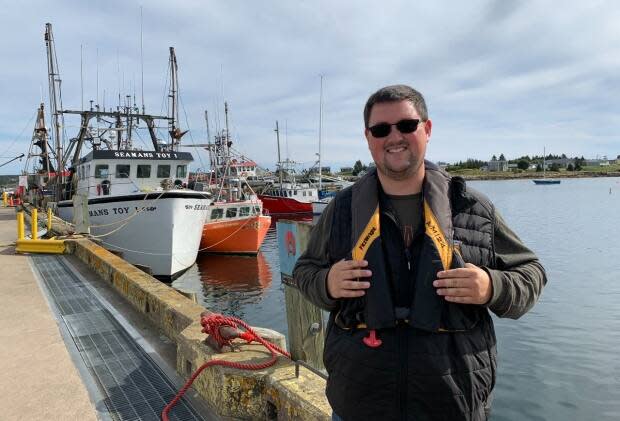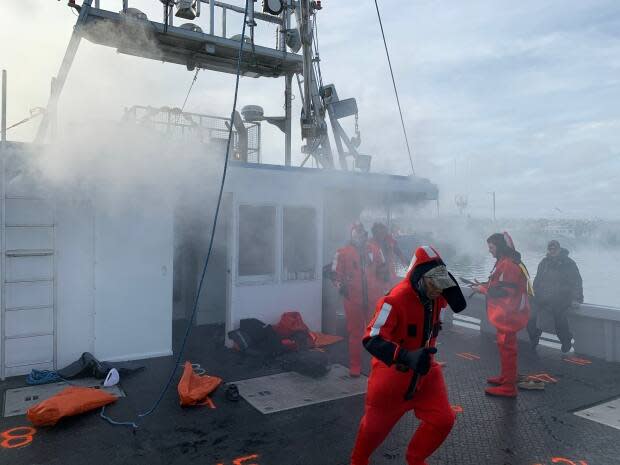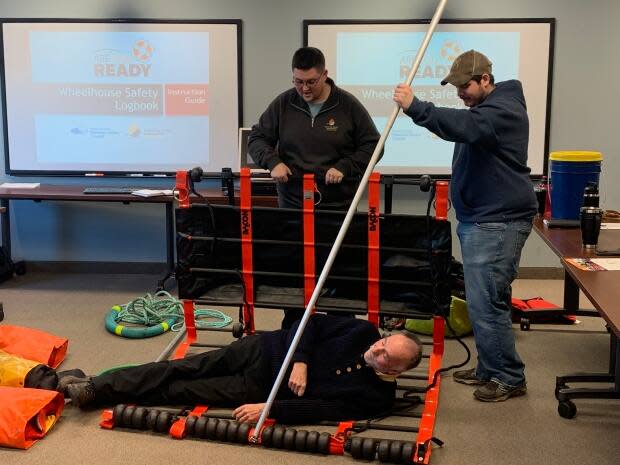Neglected safety gear on fishing boats could endanger fishermen
Most fishing boats in Nova Scotia are well stocked with safety equipment, but in some cases it's installed and then forgotten.
That means life-saving gear like survival suits aren't maintained and might not work in an emergency.
It's a problem the Fisheries Safety Association of Nova Scotia is trying to solve. It wants fishermen to regularly inspect and test their safety equipment.
"It's one thing to go out and buy all this for your vessel, but if it's not maintained it's likely not going to work for you when you need it," said Matthew Duffy, a safety adviser with the association.
Duffy has seen survival suits full of holes, rotted ropes, and life rings tied so tightly they couldn't be used.
"We did a man-overboard drill where we got the crew involved and they got their immersion suits out," said Duffy.
"One crew member opened it up and there was a squirrels' nest in one of them, you know, chewed right through the suit. That drives home the importance of looking at this stuff."
If there had been an actual emergency it would have left the crew with some tough decisions, said Duffy.
"Who doesn't get the suit, or the suit that's full of holes?"

Commercial fishing is dangerous even at the best of times.
Since 2018, there have been 28 fishing deaths in Canada, according to the Transportation Safety Board of Canada. Earlier this month, the fishing vessel the Chief William Saulis went down off Nova Scotia's coast with six people on board.
From 2015-19, there were 292 injuries in Nova Scotia that resulted in time-loss claims submitted to the Workers Compensation Board of Nova Scotia, according to Duffy. Most of those claims involved traumatic damage to fishermen's muscles, joints and backs.
The injury numbers are going down though, said Duffy. He didn't have exact numbers, but pointed to the lower rate commercial fishing businesses are paying the workers compensation board.
The board's insurance operates like regular insurance — the more dangerous a practice is, the more expensive it is to insure.
For commercial fishing, that rate has dropped more than 50 per cent since 2015. "That's all driven by less injuries, less workplace tragedies," said Duffy.

During another safety exercise, Duffy was with a fishing crew that tried to use a rescue frame — a large reinforced net used to scoop people out of the water — to haul a man out of the ocean.
They managed to get the man into the net, but when they tried to hoist him on board the rope attached to the rescue frame snapped.
"The captain said, 'You know I never thought about that, but that's been there for four years and that rope was rotten.' We've come into that a few times," said Duffy.
If equipment has been stored outside for a few years, Duffy said it should be checked for safety.

Life rings are the most problematic piece of safety gear on board a boat, according to Duffy.
In many cases, the life ring is tied so tightly it can't be untied fast enough to save someone.
He's run drills where he timed crews to see how quickly they could get the ring into the water. He said a few times he stopped counting at five or six minutes.
He said if it takes that long in a simulation it won't take any less time in an emergency. "It's time to cut that rope off and get the new one on there," he said.
The Transportation Safety Board of Canada has seen similar issues across the country, according to board member Ken Potter.
He said crews need to maintain the equipment, know how to use it and routinely practise with it.
He said there are "pockets of success" across the country where fishermen do all of that, but it's hit and miss.

Nova Scotia is one of a handful of provinces that has made big strides in educating and training fisherman in proper use of safety gear, he said. Newfoundland and Labrador, Quebec and British Columbia have also been doing that work.
Even so, the number of deaths in the commercial fishery has not decreased.
"The actual number of fish harvesters has dropped over the last 10 years or so, the number of fishing vessels has dropped, but the fatality rate of the fishing industry as a whole has not come down," said Potter. "It's stayed pretty steady at 10 fatalities per year in the last 10 years."
Duffy said that shows safety organizations like his still have work to do.
"We're all learning together and … going down the same path together to try and make the industry as a whole safer," he said.
"And I truly believe that the safety culture in the Nova Scotia fishing industry is very strong, especially from where it was 10 years ago."
MORE TOP STORIES


